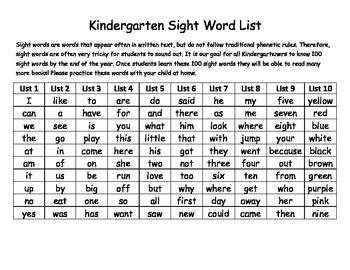
It is estimated that 50 to 75% of words find in magazines, newspapers, and books can be found on the Dolch Sight World List. The term “Sight Word” implies that the words have to be learned by sight, since some can’t easily be sounded out. Both sets of lists have been provided below. Another list created by Dolch is composed solely of nouns. He picked the words from children’s books from his time. The Dolch Sight Word List of 220 non-noun words every child should know was compiled by Edward William Dolch in 1936. Then right click and hit “Save As” the save the jpegs to your computer. If the student has mastered all of the words on that list, they get their sight word certificate and a sight word bracelet! If they are still having trouble, I look at the checklist and determine if they know enough of the words to move on, or if they need to keep practicing the words on the previous list.Please click the Dolch Sight Word List images below to open up high resolution versions of the lists. On days that I finish teaching a particular list, I do the sight word checklist. (Case in point: the CVC words cut and got are on the third grade list. (On Fridays I like to pass out Skittles, M&M’s, or Dojo points for a sight word spelled correctly!) If I could banish the Dolch grade level sight word lists, I would While I do think that the Dolch and Fry word lists are helpful because they give us the most common high frequency words, the grade level lists are just ridiculous.

Thursday: Play a sight word board game or a printable sight word gameįriday: Have students use dry erase markers to practice writing the new words and any words previously learned. Learning them helps children become more confident readers. Wednesday: Play a memory or matching game with only the words learned so far (I like to use sensory bins here!) Sight words are words that appear frequently in most of the text people read, but cant easily be sounded out. Tuesday: I ntroduce word 2 and repeat steps from Monday
KINDERGARTEN SIGHT WORD LIST HOW TO
Monday: I ntroduce word 1, talk about the letters in the word, how to say it, spell it, and identify it with a foldable book they can take home to their parents to show them the new word. Here’s a little snapshot of what it looks like:Ģ sight words per week, introduced in small groups during literacy centers, starting with List 1 I created 7 lists, of 9 kindergarten sight words each, and made it a schedule for the week, which helps the students and parents tremendously since they know what to expect. If they still need time to learn letters and sounds, I’d focus on that first!)


Then play sight word hide and seek and ask your child to find the cards. (I would make sure your students have a good understanding of letter identification before moving on to sight words. Hide sight word flashcards around the room. I started by choosing the words I wanted to use and ordering them from the least difficult to the most difficult, while still making sure they were appropriate for kindergarten. After seeing how much my students improved, I wanted to share it with all the other struggling kindergarten teachers out there! Let’s get to it!

I Googled so many sight word lists and ideas and finally created a system that worked for me and my class. (hello first year teacher problems!)įast forward to my third year of teaching, I knew I had to fix something. Every time I gave a sight word assessment, I panicked because I had no clue if I was “doing it right”. We didn’t really have a way to “teach” the students sight words, it was just a list of words my kids were expected to know by the end of the year. When I first started teaching kindergarten, I remember sight words were a beast I was not ready to tackle.


 0 kommentar(er)
0 kommentar(er)
